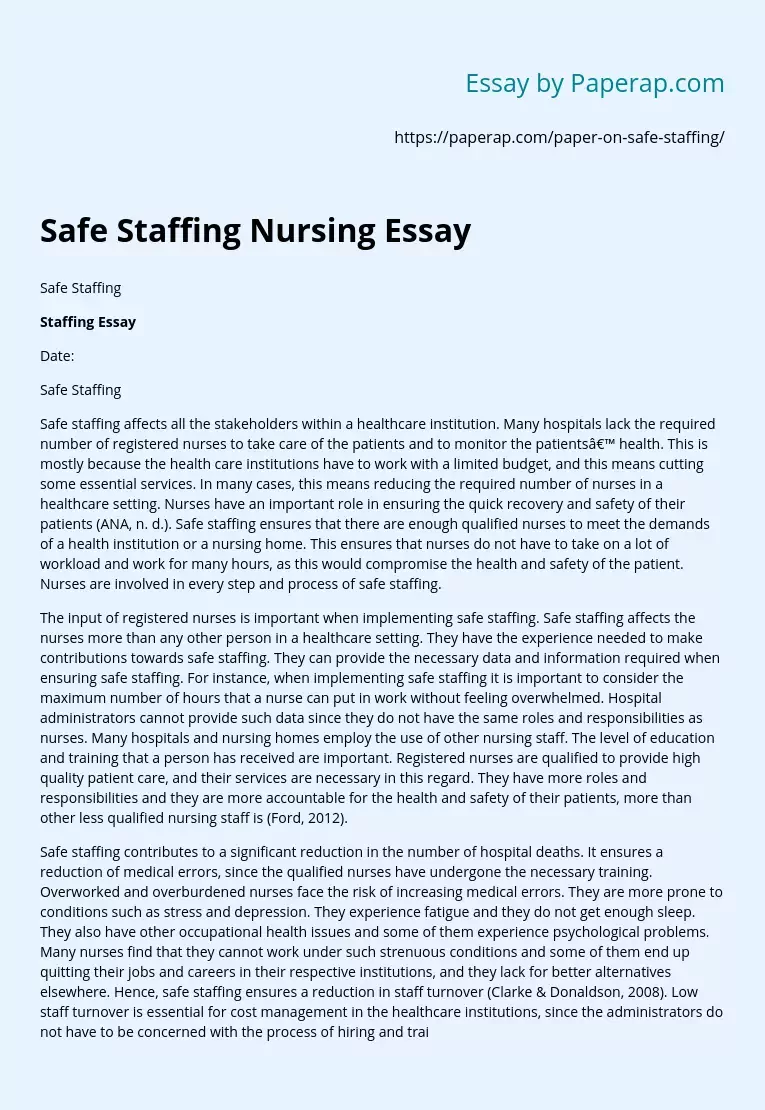Safe Staffing Nursing Essay
Safe Staffing
Staffing Essay
Date:
Safe Staffing
Safe staffing affects all the stakeholders within a healthcare institution. Many hospitals lack the required number of registered nurses to take care of the patients and to monitor the patients’ health. This is mostly because the health care institutions have to work with a limited budget, and this means cutting some essential services. In many cases, this means reducing the required number of nurses in a healthcare setting. Nurses have an important role in ensuring the quick recovery and safety of their patients (ANA, n.
d.). Safe staffing ensures that there are enough qualified nurses to meet the demands of a health institution or a nursing home. This ensures that nurses do not have to take on a lot of workload and work for many hours, as this would compromise the health and safety of the patient. Nurses are involved in every step and process of safe staffing.
The input of registered nurses is important when implementing safe staffing.
Safe staffing affects the nurses more than any other person in a healthcare setting. They have the experience needed to make contributions towards safe staffing. They can provide the necessary data and information required when ensuring safe staffing. For instance, when implementing safe staffing it is important to consider the maximum number of hours that a nurse can put in work without feeling overwhelmed. Hospital administrators cannot provide such data since they do not have the same roles and responsibilities as nurses. Many hospitals and nursing homes employ the use of other nursing staff.
The level of education and training that a person has received are important. Registered nurses are qualified to provide high quality patient care, and their services are necessary in this regard. They have more roles and responsibilities and they are more accountable for the health and safety of their patients, more than other less qualified nursing staff is (Ford, 2012).
Safe staffing contributes to a significant reduction in the number of hospital deaths. It ensures a reduction of medical errors, since the qualified nurses have undergone the necessary training. Overworked and overburdened nurses face the risk of increasing medical errors. They are more prone to conditions such as stress and depression. They experience fatigue and they do not get enough sleep. They also have other occupational health issues and some of them experience psychological problems. Many nurses find that they cannot work under such strenuous conditions and some of them end up quitting their jobs and careers in their respective institutions, and they lack for better alternatives elsewhere. Hence, safe staffing ensures a reduction in staff turnover (Clarke & Donaldson, 2008). Low staff turnover is essential for cost management in the healthcare institutions, since the administrators do not have to be concerned with the process of hiring and training other nurses. On the other hand, institutions with the adequate number of nursing staff report lower rates of adverse patient outcomes, which include pneumonia, longer hospital stays, gastrointestinal bleeding, shock, and urinary tract infections (Stanton, n. d.).
Nurses are involved in developing and monitoring nursing models to ensure that they do not compromise on their work. Those responsible for developing the models ensure that the nurses will not be overwhelmed to such an extent as to lower the quality of their work. They have to ensure that the modes work to the advantage of the patients as well. The nurses face emotional and physical risks. The nurses have to monitor the type of model they have developed, to check whether it is working towards benefiting all the people involved. If the model developed does not guarantee work efficiency, then they have to identify the problems within the model, and identify ways of changing the system. The institutions management and administration have to work together with the nurses to ensure safety in nurse staffing (NYSNA, 2011).
References:
ANA (2010). Safe staffing: The registered nurse safe staffing act H.R. 876/S. 58. American Nurses Association. Retrieved from www.nursingworld.org/SafeStaffingFactsheet.aspx
Clarke, P. S., & Donaldson, E. N. (2008). Nurse staffing and patient care quality and safety. Retrieved from http://www.ncbi.nlm.nih.gov/books/NBK2676/
Ford, S. (2012). Nurses warn of dangerous dips in safe staffing levels. Retrieved from http://www.nursingtimes.net/nursing-practice/clinical-zones/management/nurses-warn-of-dangerous-dips-in-safe-staffing-levels/5041524.article
NYSNA (2011). Role of the registered professional nurse in staffing effectiveness. Retrieved from http://www.nysna.org/practice/positions/position13_a.htm
Stanton, W. M. (n. d.). Hospital nurse staffing and quality of care. Agency for Healthcare and Quality. Retrieved from http://www.ahrq.gov/research/nursestaffing/nursestaff.htm
Safe Staffing Nursing Essay. (2019, Dec 05). Retrieved from https://paperap.com/paper-on-safe-staffing/

